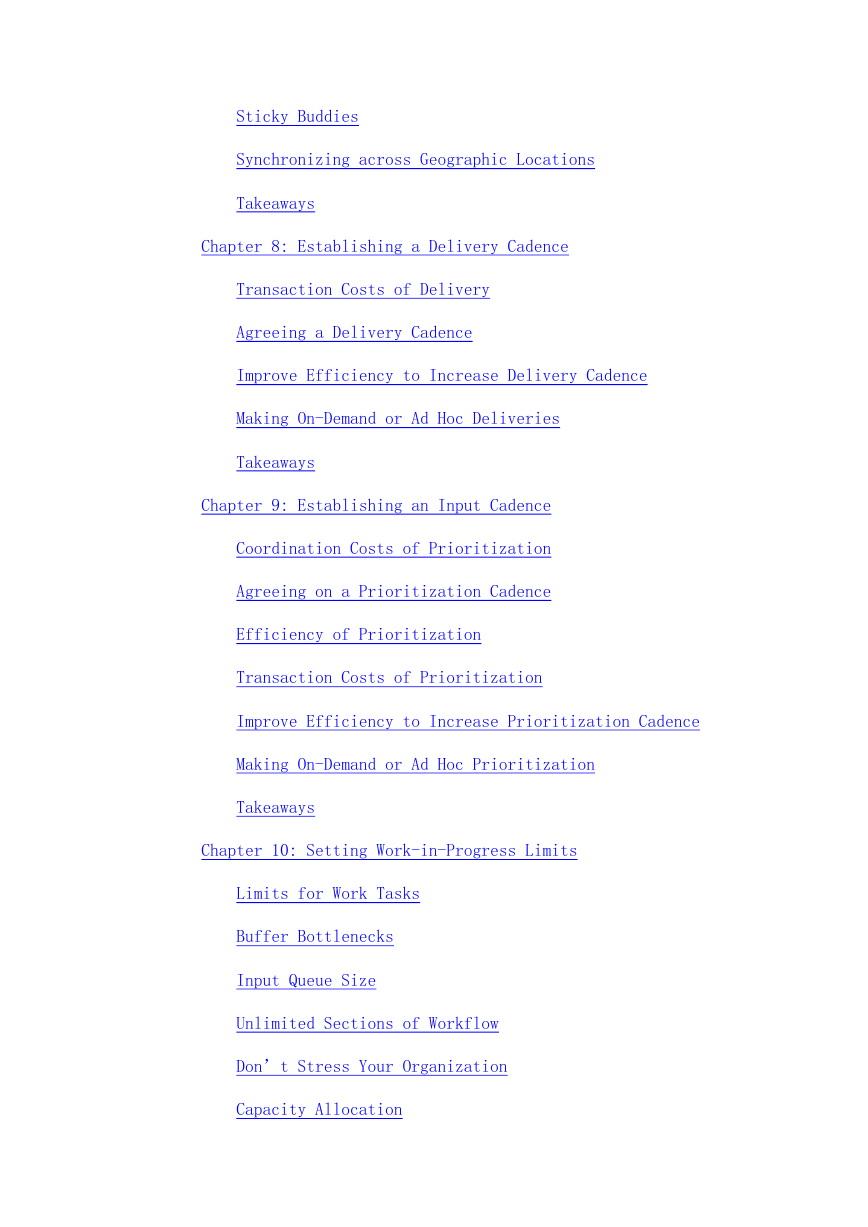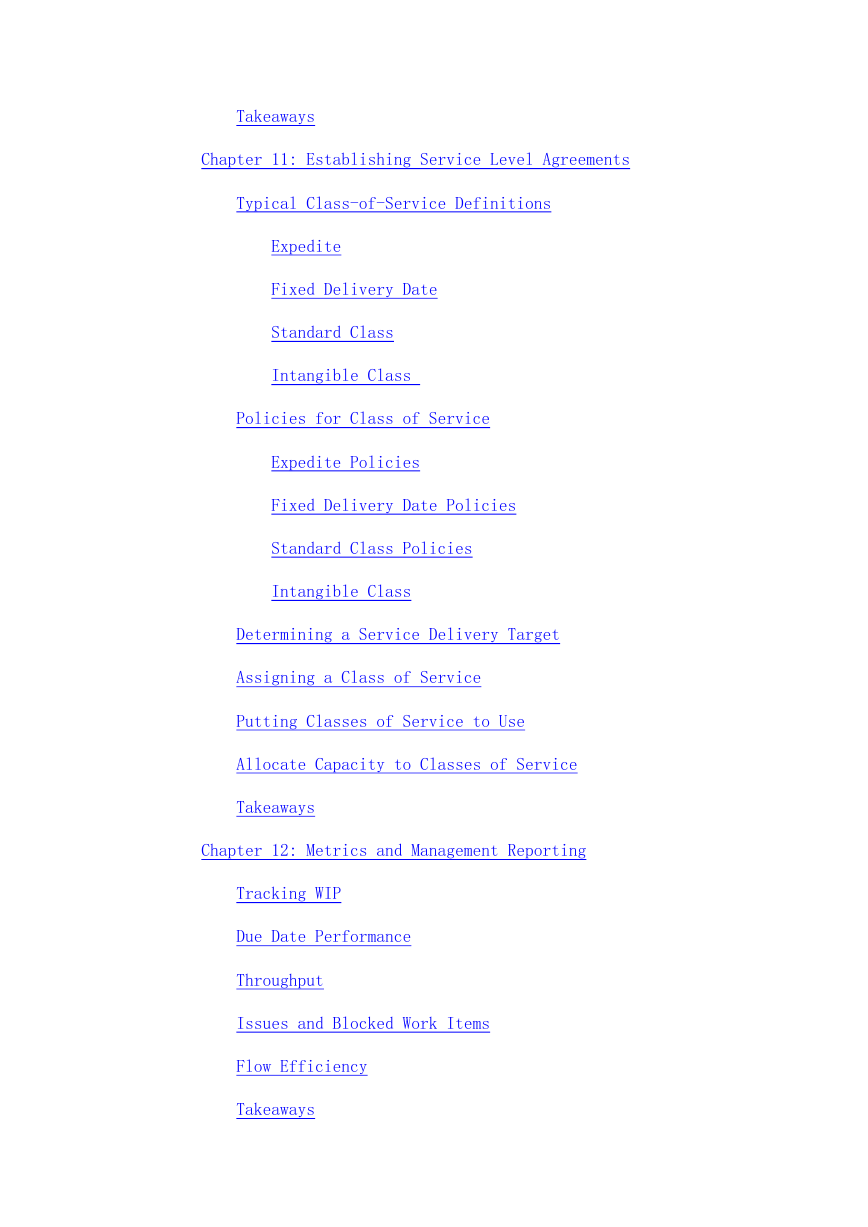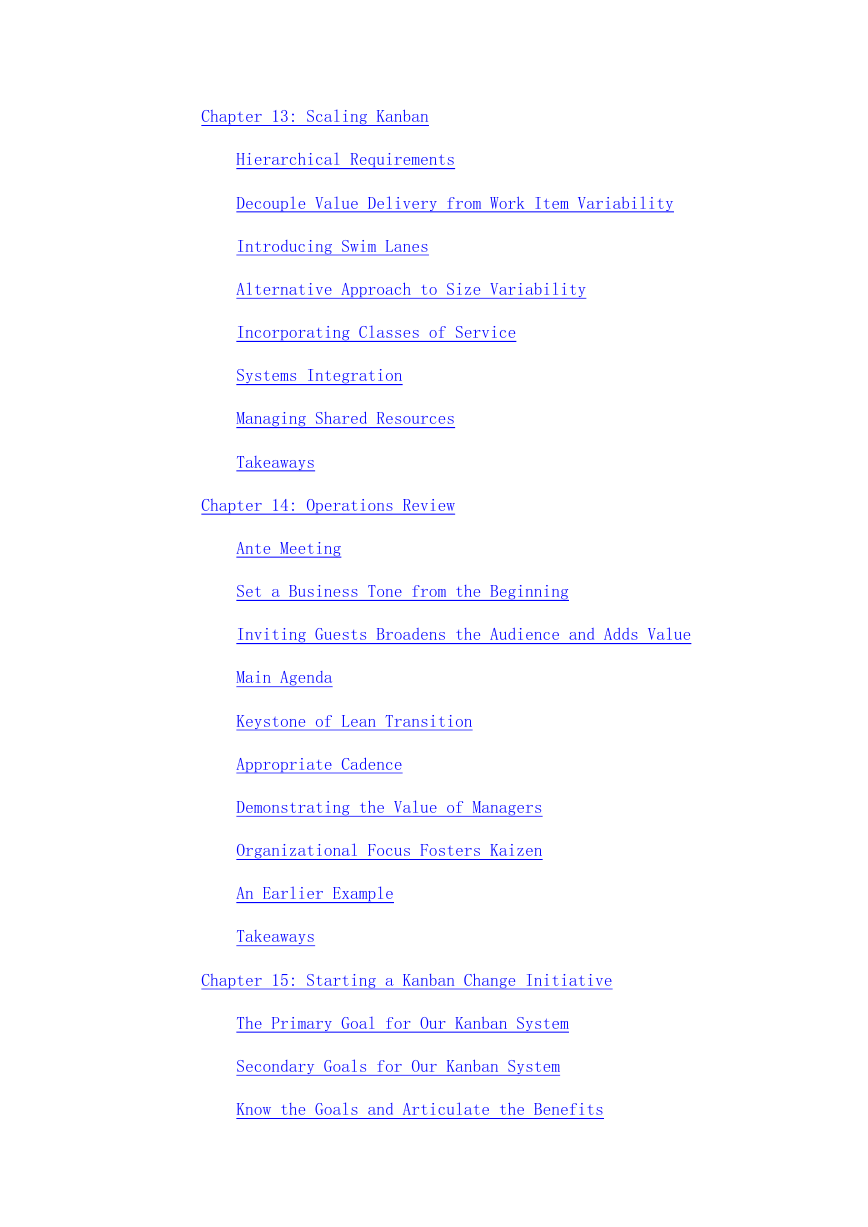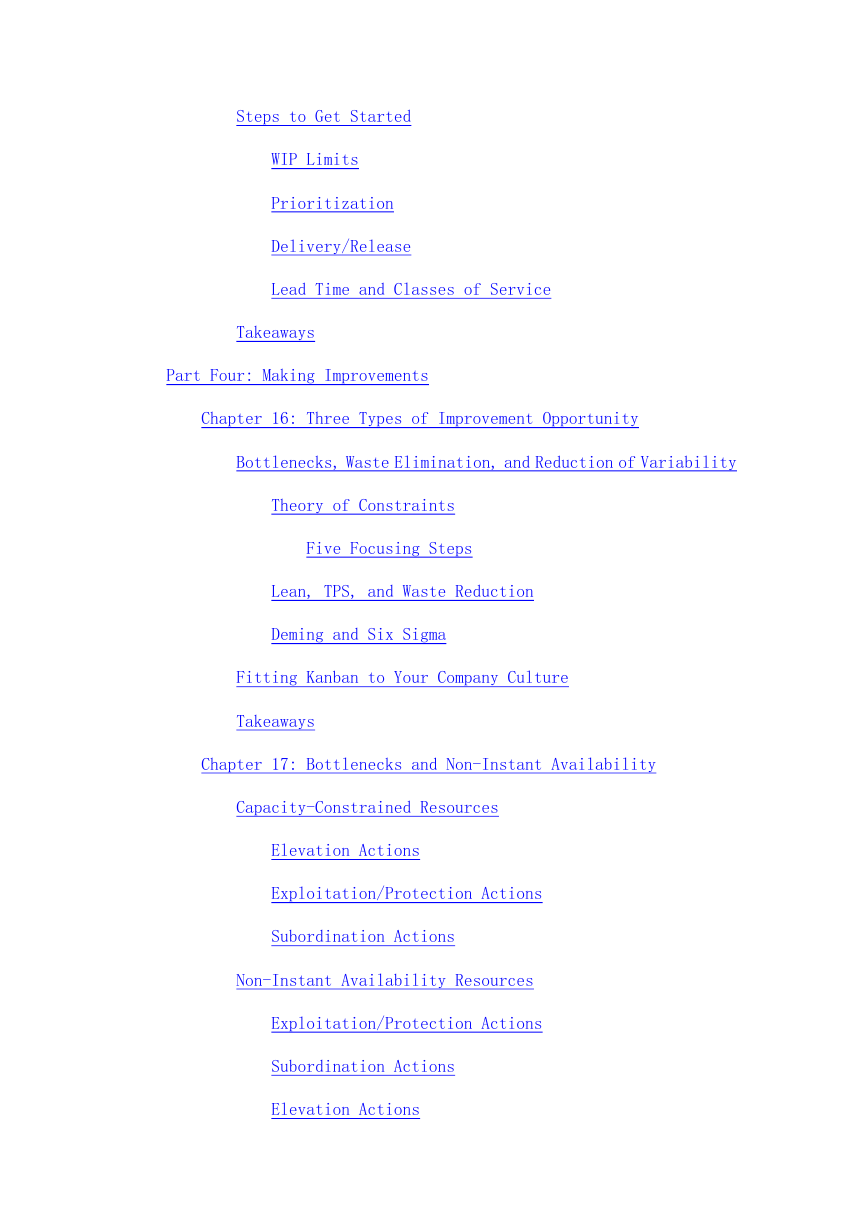Table of Contents Praise for Kanban Foreword Part One: Introduction Chapter 1: Solving an Agile Manager’s Dilemma My Search for Sustainable Pace My Search for Successful Change Management From Drum-Buffer-Rope to Kanban Emergence of the Kanban Method Kanban’s Community Adoption The Value of Kanban is Counter-Intuitive Takeaways Chapter 2: What Is the Kanban Method? What is a Kanban System? Kanban as a Complex Adaptive System for Lean Emergent Behavior with Kanban Kanban as a Permission Giver Takeaways Part Two: Benefits of Kanban Chapter 3: A Recipe for Success Implementing the Recipe Focus on Quality �
Reduce Work-in-Progress and Deliver Often WIP, Lead Time, and Defects Who’s better? Frequent Releases Build Trust Tacit Knowledge Balance Demand against Throughput Create Slack Prioritize Influence Building Maturity Attack Sources of Variability to Improve Predictability Recipe for Success and Kanban Takeaways Chapter 4: From Worst to Best in Five Quarters The Problem Visualize the Workflow Factors Affecting Performance Make Process Policies Explicit Estimation Was a Waste Limit Work-in-Progress Implementing Changes Adjusting Policies Takeaways Chapter 5: A Continuous Improvement Culture �
Kaizen Culture Kanban Accelerates Organizational Maturity and Capability Sociological Change Takeaways Part Three: Implementing Kanban Chapter 6: Mapping the Value Stream Defining a Start and End Point for Control Work Item Types Drawing a Card Wall Demand Analysis Allocating Capacity According to Demand Anatomy of a Work Item Card Electronic Tracking Setting Input and Output Boundaries Coping with Concurrency Coping with Unordered Activities Takeaways Chapter 7: Coordination with Kanban Systems Visual Control and Pull Electronic Tracking Daily Standup Meetings Release Planning Meetings Triage Issue Log Review and Escalation �
Sticky Buddies Synchronizing across Geographic Locations Takeaways Chapter 8: Establishing a Delivery Cadence Transaction Costs of Delivery Agreeing a Delivery Cadence Improve Efficiency to Increase Delivery Cadence Making On-Demand or Ad Hoc Deliveries Takeaways Chapter 9: Establishing an Input Cadence Coordination Costs of Prioritization Agreeing on a Prioritization Cadence Efficiency of Prioritization Transaction Costs of Prioritization Improve Efficiency to Increase Prioritization Cadence Making On-Demand or Ad Hoc Prioritization Takeaways Chapter 10: Setting Work-in-Progress Limits Limits for Work Tasks Buffer Bottlenecks Input Queue Size Unlimited Sections of Workflow Don’t Stress Your Organization Capacity Allocation �
Takeaways Chapter 11: Establishing Service Level Agreements Typical Class-of-Service Definitions Expedite Fixed Delivery Date Standard Class Intangible Class Policies for Class of Service Expedite Policies Fixed Delivery Date Policies Standard Class Policies Intangible Class Determining a Service Delivery Target Assigning a Class of Service Putting Classes of Service to Use Allocate Capacity to Classes of Service Takeaways Chapter 12: Metrics and Management Reporting Tracking WIP Due Date Performance Throughput Issues and Blocked Work Items Flow Efficiency Takeaways �
Chapter 13: Scaling Kanban Hierarchical Requirements Decouple Value Delivery from Work Item Variability Introducing Swim Lanes Alternative Approach to Size Variability Incorporating Classes of Service Systems Integration Managing Shared Resources Takeaways Chapter 14: Operations Review Ante Meeting Set a Business Tone from the Beginning Inviting Guests Broadens the Audience and Adds Value Main Agenda Keystone of Lean Transition Appropriate Cadence Demonstrating the Value of Managers Organizational Focus Fosters Kaizen An Earlier Example Takeaways Chapter 15: Starting a Kanban Change Initiative The Primary Goal for Our Kanban System Secondary Goals for Our Kanban System Know the Goals and Articulate the Benefits �
Steps to Get Started WIP Limits Prioritization Delivery/Release Lead Time and Classes of Service Takeaways Part Four: Making Improvements Chapter 16: Three Types of Improvement Opportunity Bottlenecks, Waste Elimination, and Reduction of Variability Theory of Constraints Five Focusing Steps Lean, TPS, and Waste Reduction Deming and Six Sigma Fitting Kanban to Your Company Culture Takeaways Chapter 17: Bottlenecks and Non-Instant Availability Capacity-Constrained Resources Elevation Actions Exploitation/Protection Actions Subordination Actions Non-Instant Availability Resources Exploitation/Protection Actions Subordination Actions Elevation Actions �
Takeaways Chapter 18: An Economic Model for Lean Redefining “Waste” Transaction Costs Coordination Costs How Do You Know if an Activity Is a Cost? Failure Load Takeaways Chapter 19: Sources of Variability Internal Sources of Variability Work Item Size Work Item Type Mix Class-of-Service Mix Irregular Flow Rework External Sources of Variability Requirements Ambiguity Expedite Requests Irregular Flow Environment Availability Other Market Factors Difficulty Scheduling Coordination Activity Takeaways Chapter 20: Issue Management and Escalation Policies �
















 2023年江西萍乡中考道德与法治真题及答案.doc
2023年江西萍乡中考道德与法治真题及答案.doc 2012年重庆南川中考生物真题及答案.doc
2012年重庆南川中考生物真题及答案.doc 2013年江西师范大学地理学综合及文艺理论基础考研真题.doc
2013年江西师范大学地理学综合及文艺理论基础考研真题.doc 2020年四川甘孜小升初语文真题及答案I卷.doc
2020年四川甘孜小升初语文真题及答案I卷.doc 2020年注册岩土工程师专业基础考试真题及答案.doc
2020年注册岩土工程师专业基础考试真题及答案.doc 2023-2024学年福建省厦门市九年级上学期数学月考试题及答案.doc
2023-2024学年福建省厦门市九年级上学期数学月考试题及答案.doc 2021-2022学年辽宁省沈阳市大东区九年级上学期语文期末试题及答案.doc
2021-2022学年辽宁省沈阳市大东区九年级上学期语文期末试题及答案.doc 2022-2023学年北京东城区初三第一学期物理期末试卷及答案.doc
2022-2023学年北京东城区初三第一学期物理期末试卷及答案.doc 2018上半年江西教师资格初中地理学科知识与教学能力真题及答案.doc
2018上半年江西教师资格初中地理学科知识与教学能力真题及答案.doc 2012年河北国家公务员申论考试真题及答案-省级.doc
2012年河北国家公务员申论考试真题及答案-省级.doc 2020-2021学年江苏省扬州市江都区邵樊片九年级上学期数学第一次质量检测试题及答案.doc
2020-2021学年江苏省扬州市江都区邵樊片九年级上学期数学第一次质量检测试题及答案.doc 2022下半年黑龙江教师资格证中学综合素质真题及答案.doc
2022下半年黑龙江教师资格证中学综合素质真题及答案.doc